A week of bloom spikes and rain
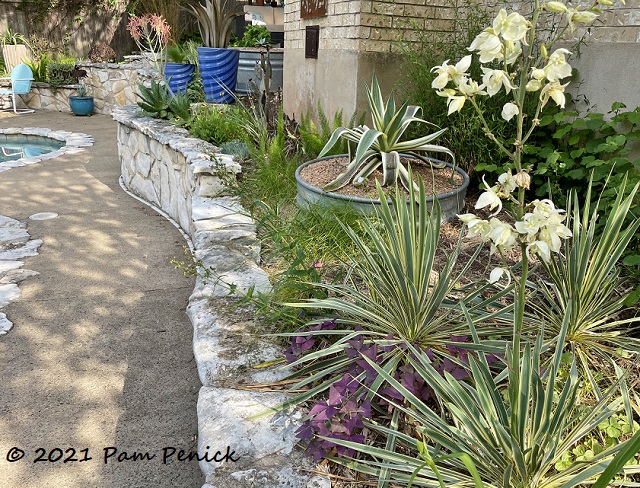
We had such prolonged rain this week that I lost track of how many inches it came to — 4 inches for sure if not 5. The garden responded to the extra water and mild May temps with a profusion of growth, including bloom spikes on yuccas, sotols, and aloes. A ‘Bright Edge’ yucca, one of a trio, sent up a spike of creamy, bell-shaped flowers that echoes the ivory stripes of an ‘Espresso’ mangave in the stock-tank planter.
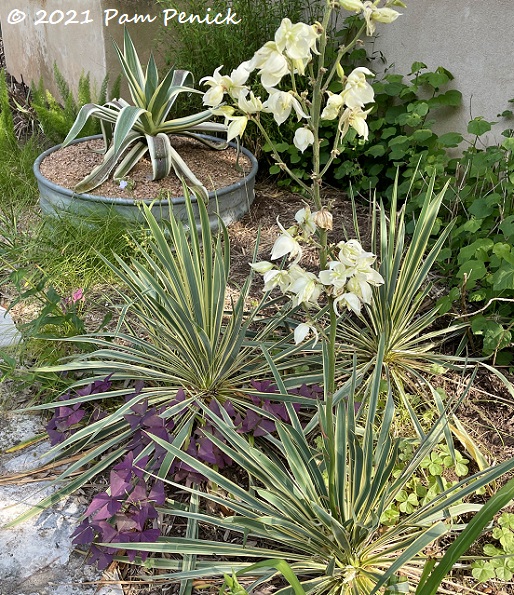
For whatever reason, the yucca flowers weren’t troubled this spring by leaf-footed bugs.
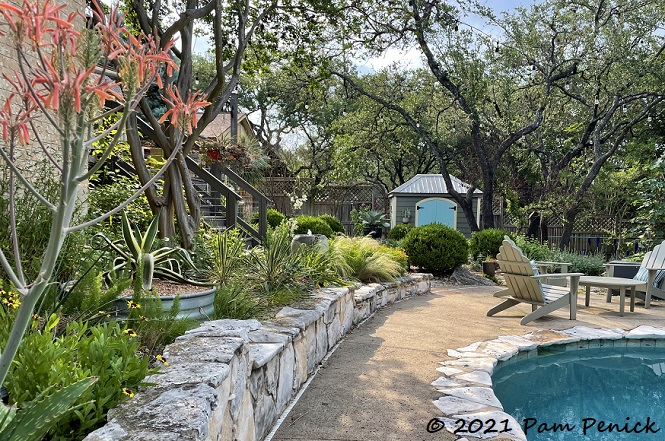
Aloe maculata, which amazingly survived the February snowpocalypse, continues to send up candelabra-shaped flower spikes. I just cut one down that had gone to seed, and now I see another coming up on a different plant. The hummingbirds will be happy!

Out front, Texas sotol (Dasylirion texana) is showing off with a trio of 15-foot bloom spikes, beloved by honeybees.
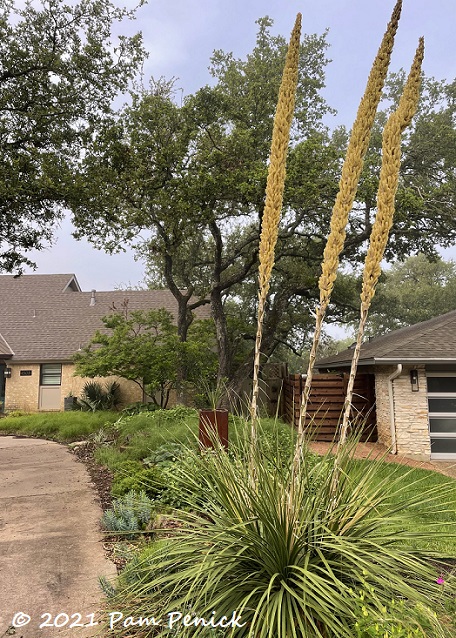
I looked out the window today — it’s raining again — and saw one of the spikes bent almost horizontal from the rain. Hopefully it’ll stand back up again when we dry out.
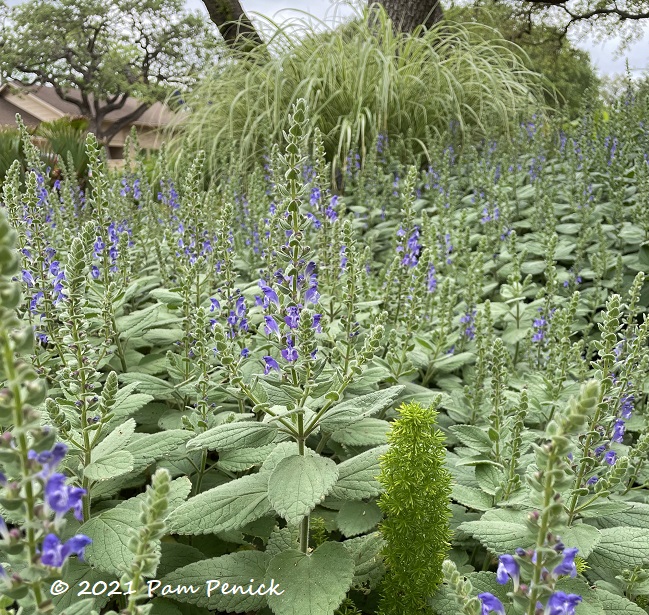
Heartleaf skullcap (Scutellaria ovata), a native Texas plant that blooms in spring and goes dormant in summer, is in full bloom and competing with the sotol for my attention. Masses of low-growing, purple bloom spikes stand atop fuzzy, blue-green leaves, which make this plant unpalatable to deer.
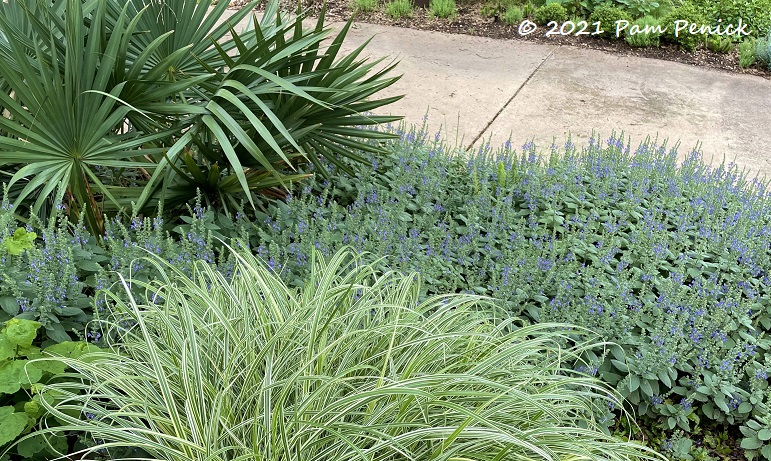
It spreads slowly but relentlessly both underground and above, by seed, and it’s welcome to cover the entire island bed. I’m often asked what takes over when the skullcap goes dormant, and the answer is visible at lower-left, in the rapidly growing Turk’s cap leaves. Turk’s cap, a summer-blooming native, takes over much of the island bed as temperatures heat up. I also have foxtail ferns along the edge that are revealed when the skullcap gets cut back. The other plants here include Sabal minor and variegated miscanthus grass, which grows well in bright shade.
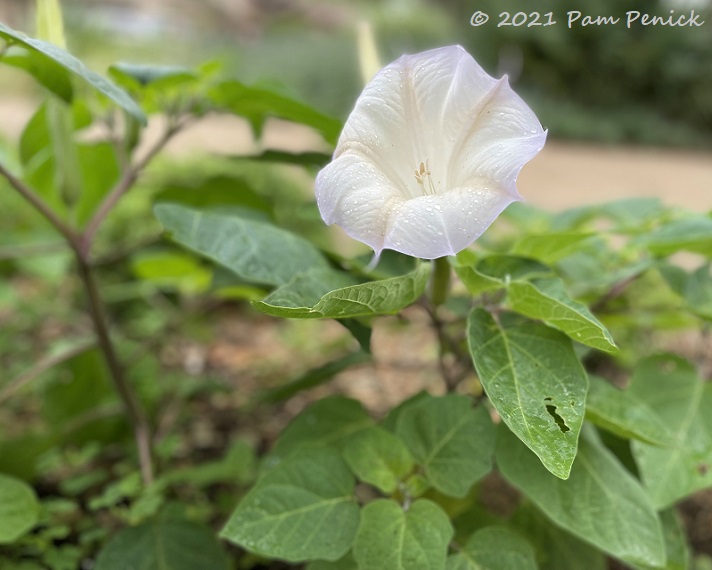
The first datura flowers opened this week, to my delight. Cloudy mornings allowed the night-blooming flowers to hang on almost to noon before collapsing.
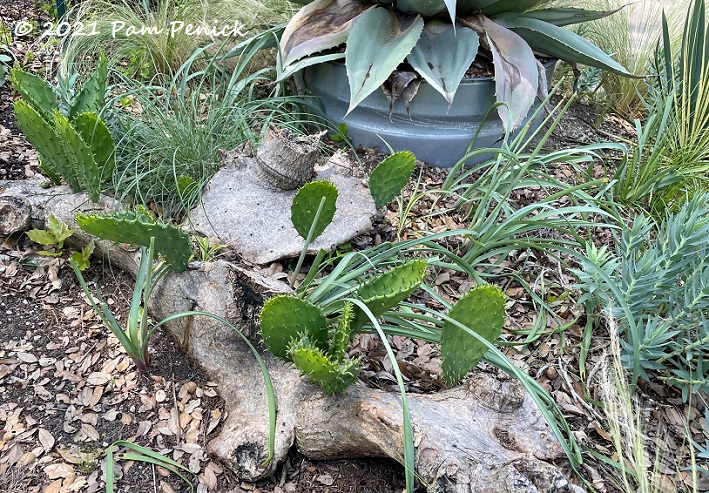
Remember the “dinosaur bone” cactus stump left behind after my ‘Old Mexico’ prickly pear collapsed in a mushy heap after the snowpocalypse? Here it is today, sprouting a dozen new pads. This passalong from Jean at Dig, Grow, Compost, Blog should soon be trying to dominate the garden again.
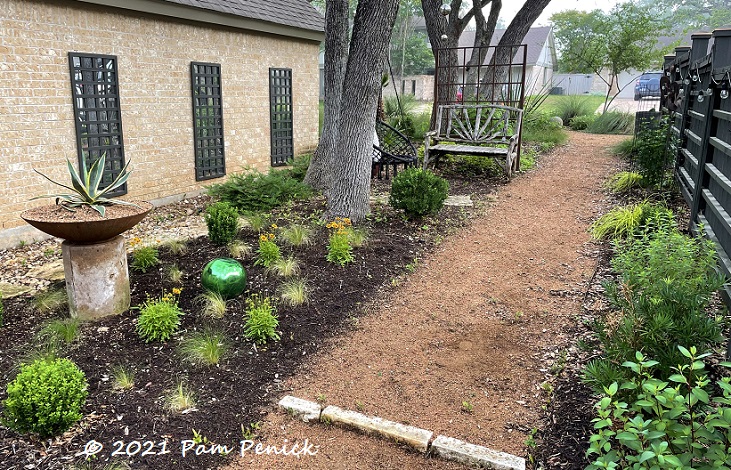
The recently replanted side garden is coming along, and deer repellant is keeping the hoofed pests off the coreopsis flowers — for now.
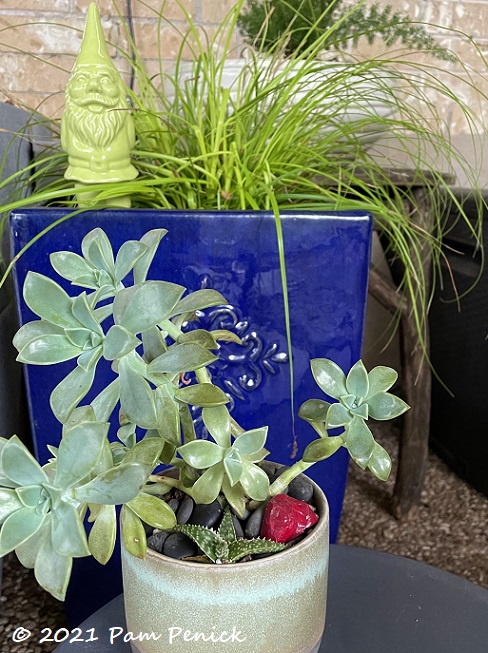
On the covered patio, container plants and garden decor add a little personality.
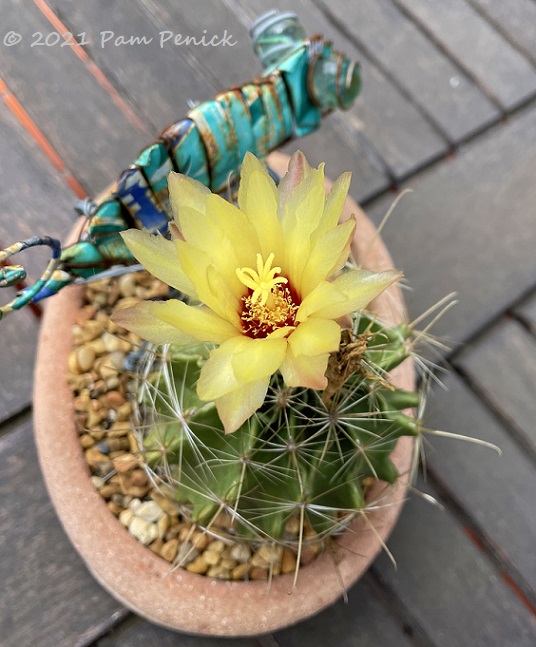
And on the sunny deck, cacti have been flowering nonstop, like this hedgehog cactus (Thelocactus setispinus)…
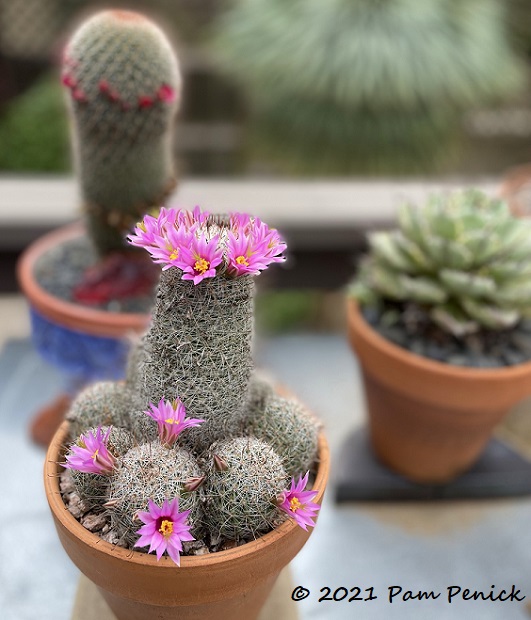
…and a pink-flowering mammillaria.
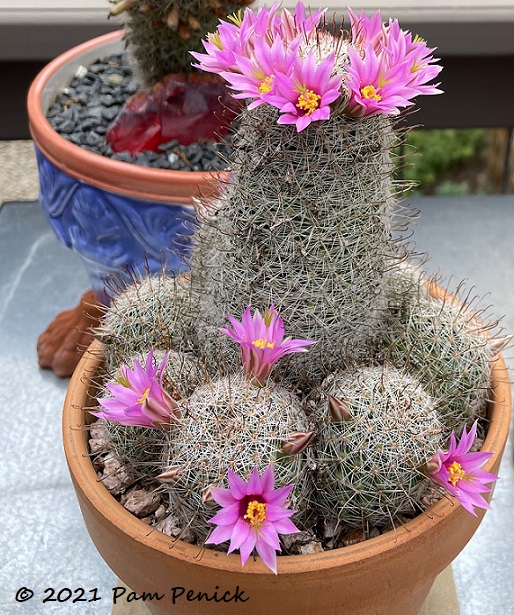
I always think of it as a flower child, wearing flowers in her hair.
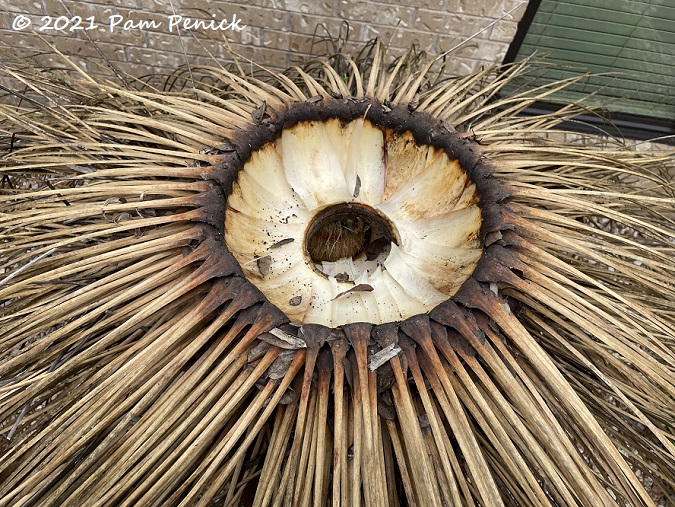
I’m still removing plants killed by the snowpocalypse. This week alone, a big loropetalum shrub and evergreen sumac and pomegranate trees came down. All are coming back from the roots, and it’ll be an experiment to see how long it takes them to regrow into the large specimens they were. I also took out the big toothless sotol (Dasylirion longissimum) in the pipe planter (above), which had slumped to one side in defeat, revealing its rotten core. See earlier pics of it in this post. No tears — it was time.
Intriguingly, the sotol pulled apart in layers, each section resembling a sunflower. The white center contained a perfectly circular hole, as if the plant were layered in place on a pole. Check out my short video on Instagram (with volume on) about these interesting layers.
I found a 5-gallon replacement plant at a new-to-me nursery, SiteOne Landscape Supply in Manor. The place has a wholesale atmosphere, but it does sell retail at several locations in Austin and San Antonio. (Thanks to Linda Peterson for the tip!) If you’re unable to find your plants at our beloved Austin nurseries this spring, it’s worth a look, and you can check inventory online.
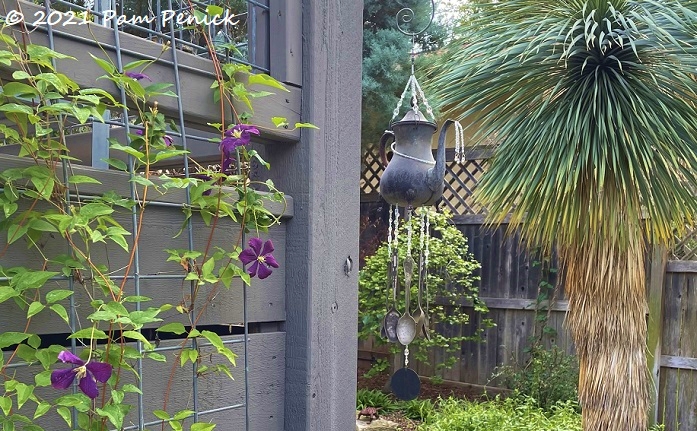
I can’t end this post with a photo of a dead plant, even if it’s already been replaced, so let’s go back and enjoy the short-lived blossoms of ‘Etoile Violette’ clematis. The Tempest in a Teapot windchime is a long-ago gift, still much enjoyed, from my husband. That’s a big ‘Sapphire Skies’ Yucca rostrata behind it. It was my first. Now I have four.
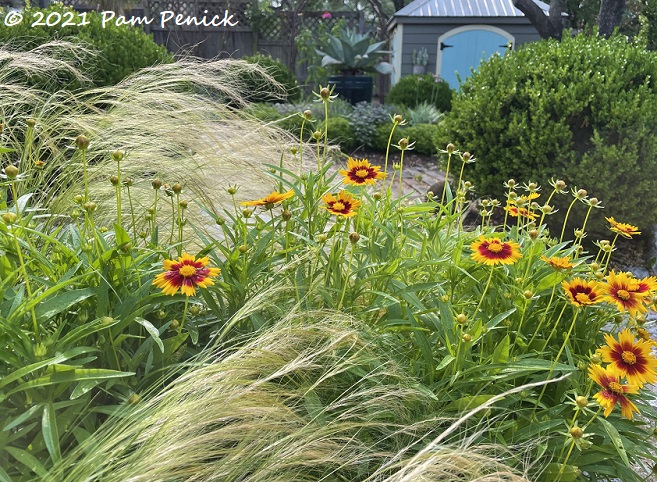
I’ll leave you with a mini-meadow view of ‘Sterntaler’ lanceleaf coreopsis (Coreopsis lanceolata) and Mexican feathergrass (Nassella tenuissima). It’s a small moment, but if you crouch it looks much larger. It all depends on your perspective.
__________________________
Digging Deeper
Come learn about gardening and design at Garden Spark! I organize in-person talks by inspiring designers, landscape architects, authors, and gardeners a few times a year in Austin. These are limited-attendance events that sell out quickly, so join the Garden Spark email list to be notified in advance; simply click this link and ask to be added. Season 8 kicks off in fall 2024. Stay tuned for more info!


It does seem as though many plants are rushing to bloom and pass along their offspring. Yours certainly are a joy to see. I see many agaves as they send out candelabras before they die. I just hope they don’t have some special knowledge of something else to come. Unfortunately some plants that appear to be coming back suddenly give up and die. This happened to my treasured white Lady Banks, a cutting from Tombstone. Started leafing out and then gave up. Like you still working on removing the losses over here
I was sorry to hear about your Tombstone Lady Banks — a loss for sure. But hopefully you’re seeing lots coming back now that spring is well underway, as I am.
Rain is magical. Maybe Mother Nature is trying to make up for pummeling you with that arctic blast. Your garden is looking very alive, even as you continue to remove dead plants. The resurrection of the Opuntia “dinosaur bone” borders on miraculous.
Isn’t it? I had confidence that it would come back from the roots — this plant is tenacious — but even so it’s been exciting to watch new pads forming.
I knew you could whip your garden back int shape after the arctic freeze. It will and is already tour ready. Interesting how the Toothless sotol grew, or died with the hole up the middle. Keep on….
Always, Lisa. And thanks. 😉
Congrats on your Old Mexico ‘dinosaur bone’ re-sprouting; I hope mine does.
They grow so fast and make a wonderful hedge. They are a favorite for me.
My fingers are crossed for your Old Mexico too, Paula. How is your garden recovering this May?
Well at least someone is getting rain! Nothing here in the PNW this spring. Love the photo of the “dinosaur bone” cactus stump… and I’m so glad it’s coming back!
It’s strange how dry you guys have been. A rainy May is not unusual for us, however. I hope you get some moisture soon!
Everything is looking great, Pam! I had the same thought as Kris above – it feels like the rain is mother nature’s effort to keep things in balance, and I very much appreciate it. It’s nice to see your new side yard plantings doing so well. I’m happy that my Old Mexico prickly pears are returning as well. They are such tough plants, and dramatic, too!
They ARE drama queens. 🙂 I’m glad yours is coming back too, Maggie.
Your garden is coming along well, Pam. Mine too. Interesting about the loss of the pomegranate, sad too. Strangely, our freezemageddon in Dallas was even worse than yours, yet my pomegranate is coming back strongly, leafing out along some stems. Other stems are dead, and I will remove them. Could the difference be the really fast drainage mine gets?
Good question, Peter. Mine is growing quickly from the roots, but only one existing limb on this approx. 15-year-old tree has shown any new leaves, and those are very few. I saved that limb, but it may get lopped later. My tree is growing on a slight slope, so the drainage should be decent. However, it’s next to the mountain laurel that really took a beating, and so I wonder if maybe that’s just a cold spot.
Good to see your garden is recovering well, and quite rapidly too considering the extent of the damage. Site One has bought up a local grower/nursery with several branches here–prices are up, quality about the same (decent). It’s a national grower, apparently.
Interesting, HB. They have a surprising number of locations around Austin.
Your garden doesn’t look like it had any damage at all. Lots of healthy looking plants. We had a ‘snow event’ in 2014 we ‘Snowtember’. People still refer to it as the one that took out half the city trees.
Half is a huge loss. Austin has lost a lot of trees too, mainly the ashes and maybe the red oaks and post oaks, among the big shade trees. Ornamental trees suffered heavily too. In my own garden all the brown has finally been cut back, and I suspect my garden was overplanted such that no one notices the missing plants except me — ha!
Love the heartleaf skullcap!
Me too! More pics coming soon.